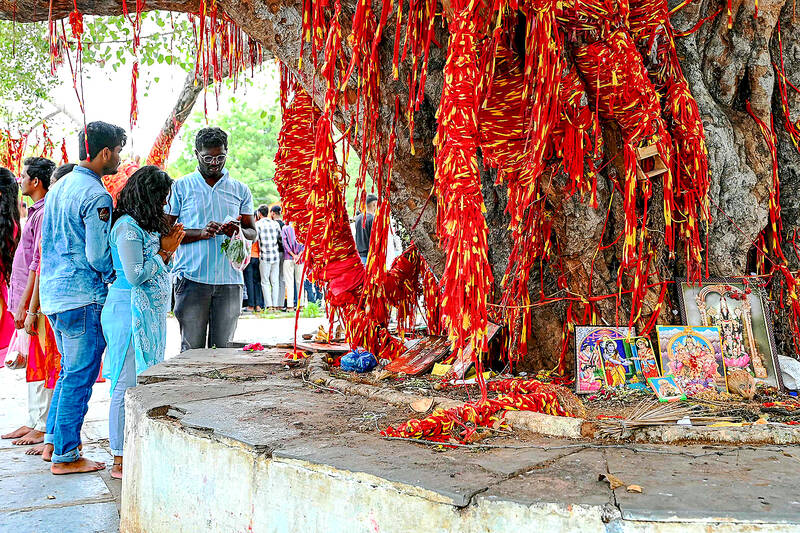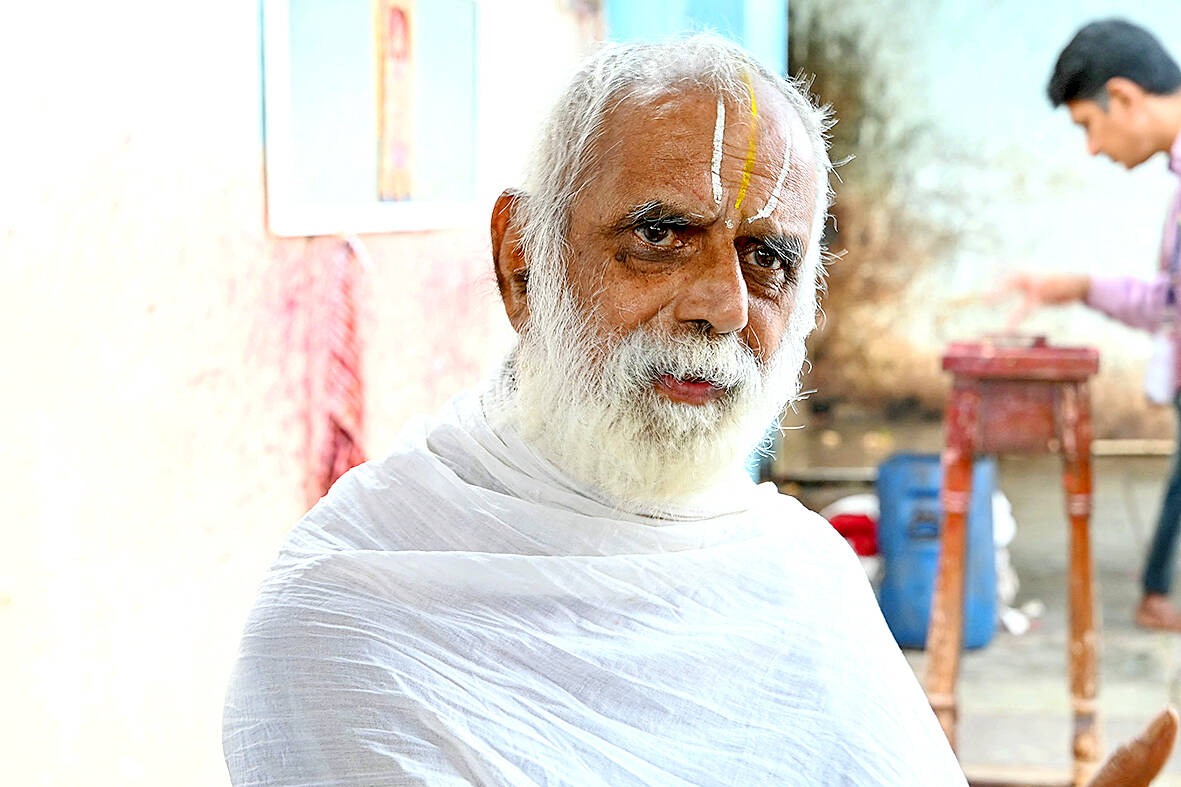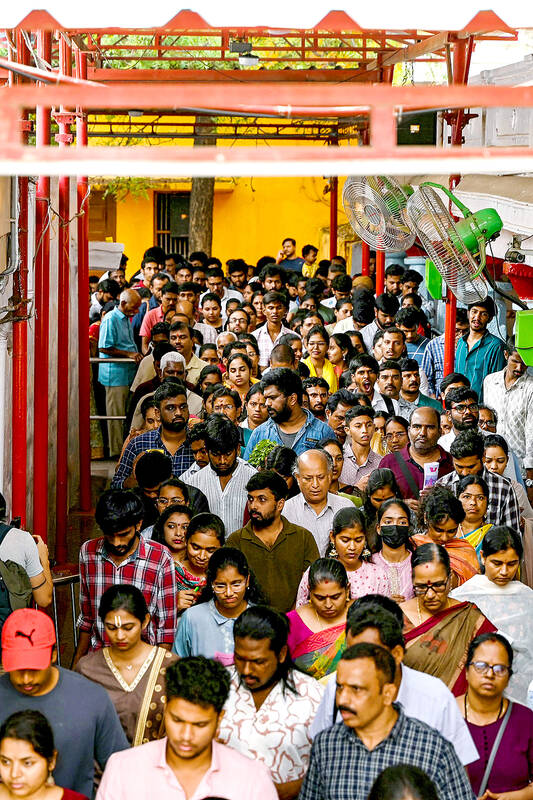Some gods grant riches and others good luck, but one deity in India offers a much less nebulous fortune to his devotees: tickets to a new life in the US.
More than 1,000 Hindu faithful visit the Chilkur Balaji temple each day in the belief that the divine presence inside can bless worshippers with a successful visa application. Those seeking a shot at the American Dream are instructed to pray for their permission to travel abroad, and to return to give thanks when they receive it.
“Every single member of my family who is in the US has come here,” said Satwika Kondadasula while walking around the temple’s sanctum. The 22-year-old said that moving to New York was a longstanding dream. She will head there this week to start her master’s degree and says she has the deity Balaji in part to thank. “I got the visa because of my capability of course, but I have luck of god as well,” she said. “I definitely believe coming here really helped me out.”

Photo: AFP
Balaji is considered an incarnation of Vishnu, one of the key gods of the Hindu pantheon known for upholding the cosmic order of the universe. The temple bearing his name on the outskirts of Hyderabad was not always known as a conduit for international travel. Its elderly priest C.S. Gopalakrishna discovered in 1984 that water spontaneously appeared before a shrine to the god when he walked around the perimeter of the temple’s sanctum 11 times. Word spread and people began visiting the temple to offer wishes for happy marriages, children, or successfully navigating the cut-throat admissions process to India’s top colleges.
‘BLIND BELIEF’
Over the decades, devotees came to believe the shrine was particularly effective helping Indians seeking to leave the country — so much so that it came to be locally known as the “visa temple.”

Photo: AFP
Pilgrims emulate Gopalakrishna’s 11 laps around the temple sanctum, returning later if their wishes are filled to circumnavigate it a further 108 times as an expression of gratitude.
The ritual demands precision. Visitors chanting Balaji’s name in unison keep track of the longer walk with the aid of yellow sheets of paper marked with numbered boxes given out by the temple. Gopalakrishna says that divine intervention is not guaranteed, and his god helps those who help themselves. “You should work hard,” he said. “Balaji will help if you have blind belief in him.”
‘DREAM LAND’

Photo: AFP
India is now the world’s fifth-largest economy and still enjoys world-beating GDP growth, but hundreds of thousands of its citizens still leave the country each year seeking better opportunities abroad.
While the diaspora spans the globe, the US remains the destination of choice.
The most recent census there showed its Indian-origin population had grown by 50 percent to 4.8 million in the decade to 2020, while more than a third of the nearly 1.3 million Indian students studying abroad in 2022 were in the US.
“America is still the dream land,” said visa consultant Sakshi Sawhney, who helps Indians negotiate the often perplexing paperwork needed to travel to Western countries.
“That is not going away anytime soon.”
‘BETTER POSITIONS’
Sawhney lived for a time in the US before returning to guide others through the process, and said she herself had visited the Balaji temple while waiting for her visa. While she does not tell her clients to pray there, she says many tell her that they had done so of their own accord.
Looming presidential elections have focused attention on the heights Indian-origin Americans have scaled. The mother of Democratic nominee Kamala Harris was born in the southern city of Chennai before her acceptance to Berkeley for her master’s degree aged 19. The wife of Donald Trump’s pick for vice-president, Usha Vance, was born in San Diego to Indian immigrant parents with family roots not far from the temple.
“It is a great, inspiring moment. Indians are moving around the world and they are in better positions right now,” said Ajay Kumar, at the Balaji shrine. Kumar, 25, has returned to the temple to give thanks to the deity, brimming with excitement before his imminent departure to Tampa Bay, where he will work as a chef.
“America is the place where all my dreams will be fulfilled,” he said.

The Democratic Progressive Party (DPP), Chinese Nationalist Party (KMT), and the country’s other political groups dare not offend religious groups, says Chen Lih-ming (陳立民), founder of the Taiwan Anti-Religion Alliance (台灣反宗教者聯盟). “It’s the same in other democracies, of course, but because political struggles in Taiwan are extraordinarily fierce, you’ll see candidates visiting several temples each day ahead of elections. That adds impetus to religion here,” says the retired college lecturer. In Japan’s most recent election, the Liberal Democratic Party lost many votes because of its ties to the Unification Church (“the Moonies”). Chen contrasts the progress made by anti-religion movements in

Taiwan doesn’t have a lot of railways, but its network has plenty of history. The government-owned entity that last year became the Taiwan Railway Corp (TRC) has been operating trains since 1891. During the 1895-1945 period of Japanese rule, the colonial government made huge investments in rail infrastructure. The northern port city of Keelung was connected to Kaohsiung in the south. New lines appeared in Pingtung, Yilan and the Hualien-Taitung region. Railway enthusiasts exploring Taiwan will find plenty to amuse themselves. Taipei will soon gain its second rail-themed museum. Elsewhere there’s a number of endearing branch lines and rolling-stock collections, some

Could Taiwan’s democracy be at risk? There is a lot of apocalyptic commentary right now suggesting that this is the case, but it is always a conspiracy by the other guys — our side is firmly on the side of protecting democracy and always has been, unlike them! The situation is nowhere near that bleak — yet. The concern is that the power struggle between the opposition Chinese Nationalist Party (KMT) and their now effectively pan-blue allies the Taiwan People’s Party (TPP) and the ruling Democratic Progressive Party (DPP) intensifies to the point where democratic functions start to break down. Both

This was not supposed to be an election year. The local media is billing it as the “2025 great recall era” (2025大罷免時代) or the “2025 great recall wave” (2025大罷免潮), with many now just shortening it to “great recall.” As of this writing the number of campaigns that have submitted the requisite one percent of eligible voters signatures in legislative districts is 51 — 35 targeting Chinese Nationalist Party (KMT) caucus lawmakers and 16 targeting Democratic Progressive Party (DPP) lawmakers. The pan-green side has more as they started earlier. Many recall campaigns are billing themselves as “Winter Bluebirds” after the “Bluebird Action”